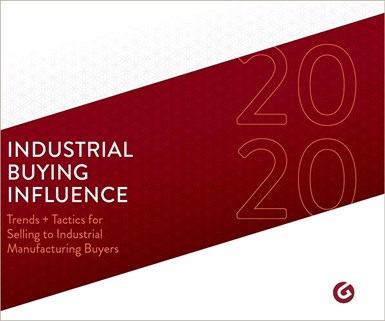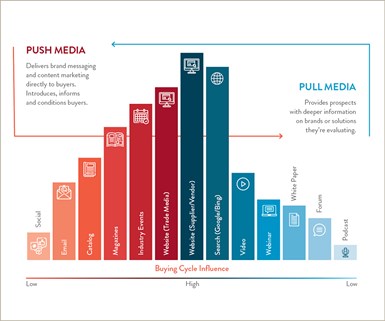B2B Research: A Powerful Marketing Tool
The Gardner Business Media Industrial Buying Influence 2020 study findings can be used as a powerful marketing tool. The study provides demographic and psychographic details that help you better understand customers and prospects. We know knowledge is power and knowing how B2B industrial buying dynamics are changing is a key to successfully empowering your marketing.
#brandbuilding #leadgeneration
Gardner’s Industrial Buying Influence 2020 Can Help Sharpen Your Game

By Mark Semmelmayer, CBC
Chief Idea Officer
Pen & Inc. Marketing Communications
First published in 2011 as Media Usage in Manufacturing, Gardner Intelligence’s Industrial Buying Influence series examines how media and marketing impact industrial buying. The 2020 survey, the fifth in the series, focused on the industrial buying team. The process with which buying teams evaluate, research, and decide on purchases, and how media and marketing influence each stage of that process.
Since 2015, it’s been my honor, at Gardner’s request, to summarize key survey findings in a digestible, big picture nugget. Suggesting practical insights to making you, as a B2B marketer, better focused and more successful. I can’t summarize the entire survey, but it’s full of relevant information. Read it all here: https://collections.gardnerweb.com/ibi
A full read can give more context than I can provide in a short format. But, we’re all busy, so here’s my CliffsNotes® version.
Methodology:
|
Respondents: |
884 Industrial Manufacturing Professionals, via mail, email or phone |
|
Demographics: |
Respondents represented a cross section of manufacturing companies: varying industries, sizes, and revenues |
|
Focus: |
Respondents were instructed to consider their purchase process when addressing survey questions |
Macro Takeaway:
There’s a youth movement afoot. Past Gardner research indicated younger buyers & influencers were beginning to take seats at the table. In 2015, the trend was a babbling brook. It’s becoming a steady stream. Now, 61% of buying team members are age 40-51.
The implications for B2B marketers are clear. As age ranges of buyers and influencers shift, so do their media consumption preferences. With a nod to Marshall McLuhan, medium and message are probably more strongly linked than ever. I think there are three distinct age groups involved in the process, with different media “habits,” defined in my terms as:
|
Digital Copers: |
>50, whose corporate lives started before widespread digital technology |
|
Digital Adopters: |
40-50, for whom digital tools were part of their career almost from the start |
|
Digital Natives: |
<40, born with a smart phone in their hands |
Look around your own organization. You’ll probably see more than a grain of truth here. Research has shown, in the population at large, each of these groups gather, evaluate and process information in different ways. And, that’s the big point.
What Does Today’s Buying Dynamic Look Like?

Since inception, the report’s detailed the makeup of buying teams. Not surprisingly, it’s changing. To a fair extent, the buying team, and the roles of its members, vary with the size of the enterprise. But small or large, the basic process is constant:
Discovery→Research→Evaluation→Decision
Buyers are always evaluating, but there are two purchase triggers; need and opportunity. NEED: “Machine A breaks down regularly. We need a new one.” OPPORTUNITY: “If we can get Machine A to talk to Machine B…and to shipping…we can do it better, faster and cheaper.”
The composition of industrial buying teams mandates solutions-focused marketing strategies, that are content-based and integrated across channels. Regardless of facility size or purchase type, typical buying cycles require over 3 months and require:
• More than 4 people
• Multiple vendors
• Specific business need
Parsing Today’s Buying Team
Title
Manager (74%) is the most common title influencing all buying cycle stages
Age
41-50 (61%) is the most common age range represented on the industrial buying team
Smaller Facilities
- Likely to have sole decision maker
- Likely to rely on magazines and vendor websites
- Likely more motivated by service and cost
Larger Facilities
- Largest average buying team (4+ participants)
- Likely to buy on project basis, less motivated by service and cost
- More likely to have younger (21-30) buying team members
Next Gen Buyers
- Likely to be involved in discovery/research phases
- Likely to use video in the buying process
- Rely more on trade media websites and content marketing
Integrated Marketing Is Key
90% of industrial buyers use a minimum of 3 different media “types” to make their decision. They’re most influenced by trusted information sources and known, trusted brands. While this may shift over time, respondents cited magazines and websites as 3X more influential in vendor evaluation and selection than non-industry sources like search and social. The top 5 information sources cited were:
- Supplier Websites
- Online Search
- Industry Websites
- Trade Events
- Trade Magazines

While this hierarchy is dominated by “Push” media, “Pull” media, like Online Search begins to show a shift in buyer habits. To be on the same page, here’s an overview of “Push” and “Pull”:
Push
- Trade Media Magazines
- Industry Events
- Catalog
- Social Media
Pull
- Website (Supplier, Industry, Trade Media)
- Search (Google/Bing)
- Video
- Webinar
- White Paper
- Podcasts
The need for an integrated marketing communications strategy is rooted in the digital psyche of individual buying team members, and how they gather trusted information. Younger team members lean to “Pull” media, older to “Push”. Those in between are a hybrid. Bottom line, you need both to be effective.
Parting Thoughts
Brand and the Buying Cycle
The foundation of successful industrial marketing is continuous brand development. Your brand is not your product, it’s what your product represents in your buyer’s mind. A product solves their problem. A brand is the one they feel solves it best. Contextual display advertising and content marketing are leading influencers in developing awareness and brand.
It Is About Brand
Buyers purchase based on need or opportunity — nearly 97% of decision processes involve the evaluation of at least one alternative vendor. There’s opportunity to grow your market share if your brand is known and present across channels.
Need more information?
Mark Semmelmayer, CBC
Chief Idea Officer
Pen & Inc. Marketing Communications
Saint Simons Island, Georgia
770-354-4737
LinkedIn
About the Author
Mark Semmelmayer, CBC
Mark is a past international chairman of the Business Marketing Association (BMA), the 2015 recipient of BMA’s prestigious G. D. Crain Award and an Inductee into the Business Marketing Hall of Fame. A 40-year B2B marketing pro, including 32 years with Kimberly-Clark, he’s the founder and Chief Idea Officer of Pen & Inc. Marketing Communications, a consultancy in Saint Simons Island, GA.
RELATED CONTENT
-
3 Things to Know Before Launching a Social Media Ad Campaign
This article provides a starting point for the new social media advertiser looking to make an impression on the manufacturing industry buyer. The author will cover the importance of defining a campaign objective, the basics of building an audience, and the best practices for crafting your message.
-
Improve Your Facebook Group Engagement
In this article, you’ll discover how to use three new Facebook Group features to engage your target audience and promote meaningful conversations.
-
Gardner Business Media Survey Helps Manufacturing Marketers Better Reach Buyers with New Data and Insights on Industrial Buying
The Gardner Business Media Industrial Buying Influence (IBI) 2020 examines behaviors and influencers impacting the industrial manufacturing technology purchase process. The series offers a comprehensive analysis of how media and marketing impact the industrial buying cycle in discrete parts manufacturing. Specifically, the pace and the process by which buying teams evaluate, research and decide on purchases; and, the media types and messaging strategies that inform each stage of that purchase process. Results include observations and raw data investigating primary trends in B2B industrial marketing and media usage.


